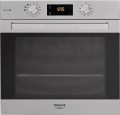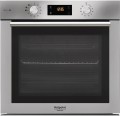Controls
The type of control panel installed in the oven. To date, there are such options:
—
Rotary knobsswitches. Controls based on classic rotary knobs, known to many users for other types of kitchen appliances — primarily classic cookers. This type of control can be found in both low-cost and advanced models: the specifics of the operation of ovens are such that many functions (both basic and additional) are conveniently controlled with rotary knobs and the simplest mechanical controls, and a complex electronic circuits. However, rotary knobs in their pure form are not used very often today — much more often they are combined with buttons or touch controls (see below).
—
Push-buttons. Push-button controls are typical of the electronic type and use complex control circuits, making this type of control suitable for models with a wide range of additional features. However, pure push-button controls, without rotary knobs, are very rare in ovens. On the one hand, for some functions, such controls are less convenient than rotary knobs; on the other hand, they are rather unusual for ovens, which can cause additional discomfort for the user.
—
Touch controls. They are in many ways similar to push-buttons (see above). The main difference between touch controls and buttons is that the touch controls respond to touch, not to press. Thanks to this, using such pane
...ls is much easier. In addition, the touch sensors give the device a stylish look and are easy to clean because they do not have protruding parts. Such controls in their pure form, not combined with rotary knobs, are also quite rare. However, for several reasons, there are still much more touch controls models than push-button ones.
— Rotary knobs with push-buttons. Control panels equipped with both rotary knobs and buttons. See above for more details on both. Here we note that the combination of two types of control allows not only to combine their advantages but also provides additional convenience: some functions of the oven can be tied to rotary knobs, others to buttons, linking each function with the type of control that is optimal for it. Due to this, this option is the most common today.
— Rotary knobs with touch controls. Combined control with rotary knobs and touch controls (see above for more on both). Like the “rotary knobs with push-buttons” option (also described above), it is very convenient because each function of the oven is tied to the type of control that is optimal for it — either to the rotary knob or to the touch controls. This option is much less common, but this is not due to inconvenience but primarily to the high cost of touch controls compared to push-buttons. Accordingly, it is used mainly in models of the middle and top classes.
— Pop out knobs. A variation of the rotary knobs described above, in which the knobs can be recessed into the control panel. Usually, pop out knobs are designed to stay outside only during the direct setting of the operating mode, and for the time when the oven is not in use or works in one mode, they can be hidden. It gives the unit a neat appearance, reduces the places where dirt can accumulate and makes the front panel easier to clean. Unlike rotary knobs, pop out knobs are mainly used in electrical models.
— Pop out knobs with push-buttons. Controls combining Pop out knobs with push-buttons. Both of these types of controls are described above, and in itself, this option is almost the same as a combination of buttons with rotary knobs (also see above).
— Pop out knobs with touch controls. A variant, by the name, combines pop out knobs and touch controls. Each of these types of control is described separately above, and their combination is almost no different from the combination of rotary knobs with touch controls (also see above). Except with the correction that recessed knobs keep the number of protruding elements on the control panel to an absolute minimum.Cooking temperature
The cooking temperature range allows you to understand which special tasks are subject to the oven. The lower temperature from which the oven starts heating, usually, is in the range of +30 to +50 ˚C. So, for example, the minimum heating temperature at
+30 ˚C allows you to defrost products. Models with a minimum of
40 ˚C and
50 ˚C allow you to heat ready meals, heat tableware (before serving), dry crackers, etc.
Number of modes
The number of cooking modes provided in the design of the oven. In this case, the cooking mode means the general opertaion mode — for example, “heating”, “heating + convection”, etc. Accordingly, this indicator strongly depends on additional equipment (see "Features"). However, even in similar models, the number of modes may be different. In general, the
more cooking modes, the more cooking options, the easier it will be to choose the optimal mode for a specific situation.
Guides
Type of guides for installing baking sheets that are used in the oven.
—
Frame. Classic guides have the form of slots with protrusions in the side walls of the oven. This design is simple and inexpensive. However, it is not very convenient — when removing baking sheets, you have to pull your hand into a heated oven, which means you will need a mitten or potholder. And the extraction itself may require effort, especially if the guides are dirty and the trays go tight in them.
—
Telescopic. Retractable guides on which the baking sheet “leaves” the oven, usually, immediately when the door is opened. Such devices are more convenient than frame ones, but they are more expensive and not suitable for all situations (for example, sometimes to check a dish you only need to open the lid without pulling it out). Therefore, in most models,
telescopic guides are only on one level. But
telescopic guides on two levels or even
three levels already classifies the device as a top segment.
Oven cleaning
The type of inner cleaning provided in the oven. Note that pollution has to be removed with a rag or sponge, but modern ovens often provide various tricks that facilitate the process. The options might be:
—
Catalytic. A special wall coating is used in ovens with this cleaning method: it breaks down fats and other stubborn dirt into constituent elements that can be easily removed. The effectiveness of such a coating decreases over time, but it is enough for at least several years of full use. It should be noted that the catalytic coating can be implemented by applying it to special removable plates that are installed on the back or side walls of the oven chamber.
—
Steam cleaning. Cleaning with hot steam, which softens dried-on dirt and partially breaks down fats. In some models, there is a built-in steam generator for this, in others it is enough to put a container of water in the working chamber and turn on the cleaning program.
—
Pyrolytic. Cleaning by heating the chamber to a very high temperature — about 500 ° C. At this temperature, most of the contaminants are incinerated into ash, which can then be easily removed. Pyrolytic cleaning is considered the most effective, but ovens with this function are expensive, time consuming, require significant electricity/gas consumption, and can lead to unpleasant odors.
Energy class
This indicator characterizes how economically the oven consumes electricity. Initially, classes were marked in Latin letters from
A(highest) and further down as they went down. Later improved classes
A +,
A ++, etc. appeared (the more pluses, the better). More energy-efficient models are more expensive but can pay for themselves in the process of use, especially if you have to cook often and in large quantities.
Dimensions (HxWxD)
In the case of ovens, the dimensions determine not only the sizes, but also the conditional form factor and the possibility of installing models. Dividing by height, the devices can be
compact(low) for installation in hanging cabinets and
full-sized — classic ovens for installation under the countertop. As for the width, in addition to
standard models of 60 cm, there are
narrow (45 cm) and
wide (90 cm) models to interact with similar wide hobs.

